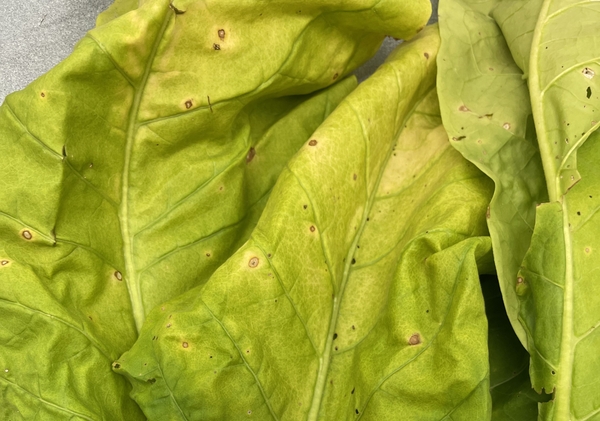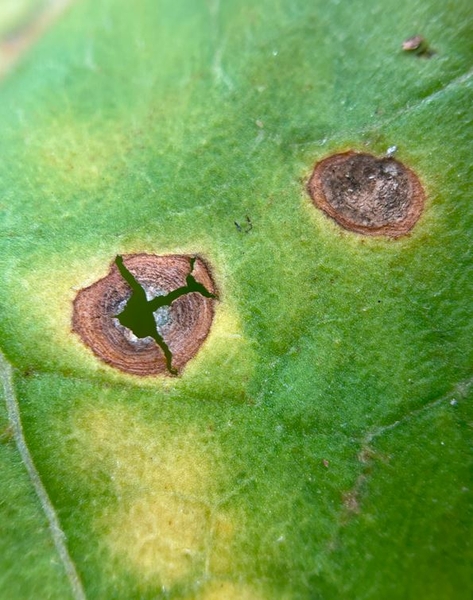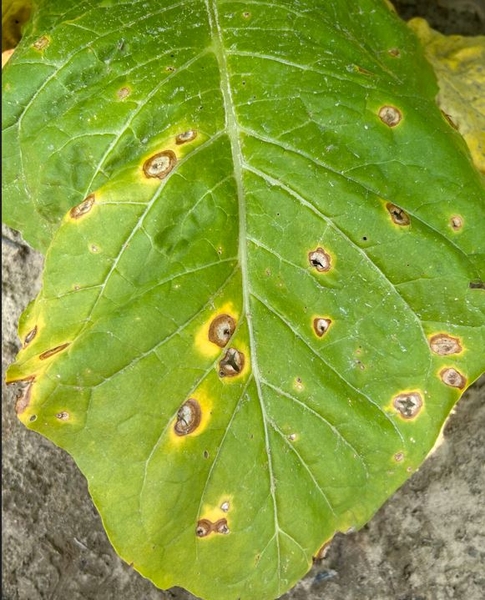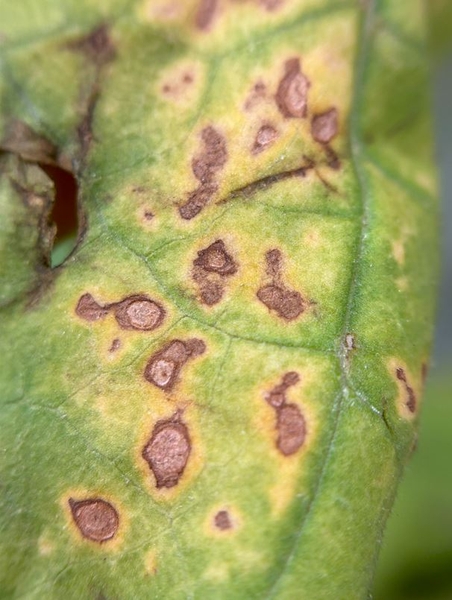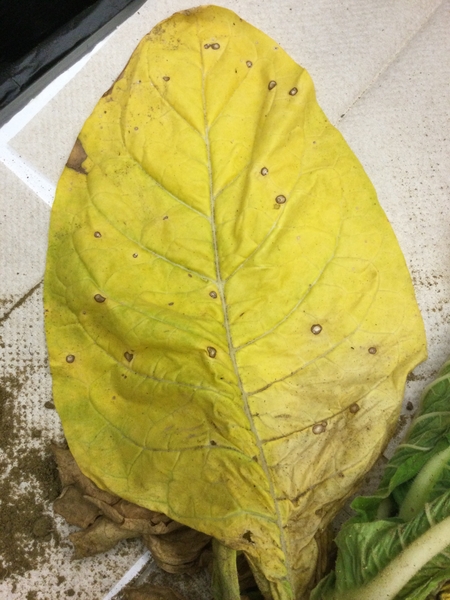Introduction
Target spot is a potentially devastating leaf spot disease in North Carolina tobacco. First reported in Brazil in 1948, target spot was first described in the United States during an epidemic that occurred in North Carolina in 1984. Throughout the 1990s, the disease spread throughout most tobacco-producing states in the Southeastern United States. Target spot of tobacco has been frequently reported in South America, South Africa, the southern United States, and Canada. Currently, target spot has been reported in over 20 counties in North Carolina with average annual losses of over $7 million.
Pathogen
Target spot is caused by a soil-borne fungal pathogen, Rhizoctonia solani (teleomorph: Thanatephorus cucumeris) species-complex, which is split into numerous anastomosis groups (AG). AG2-2, AG3, and AG4 affect tobacco, along with several other hosts. The Rhizoctonia solani species-complex has over 200 plant hosts.
Symptoms
In the greenhouse, Rhizoctonia solani causes ‘damping off’ or soreshin, which inhibits seed germination or causes seedling collapse. The lower stem of the affected seeding will often have a sunken, reddish-brown lesions.
In the greenhouse or in the field; small (2-3 mm), white to tan spots (Figure 1) will develop on the lower leaves closest to the soil. As the disease progresses, the spots may enlarge and a series of darker brown rings will develop within the tan spot, giving the characteristic target symptom (Figure 2). The centers of the spots rapidly become very thin and shatter when a slight pressure is applied, leaving cracked spots or holes (Figure 3). The spots may be surrounded by a yellow halo. In severe cases, the disease will affect most or all of the lower leaves and symptoms will spread up the tobacco plant.
Diseases With Similar Symptoms
Brown Spot (Alternaria alternata, Figure 4). This pathogen can cause a brown necrotic leaf spot that also produces concentric rings, but abundant sporulation by this pathogen within lesions can be diagnostic of brown spot. See the Brown Spot of Tobacco factsheet for more information.
Erwinia Leaf Spot (Erwinia spp., Figure 5). This pathogen usually causes hollow stalk and barn rot, but may produce foliar symptoms in years with heavy rain. The pathogen causes water soaked lesions, which turn brown with concentric rings. Bacterial streaming can be observed from the cut margin of the spots under a microscope.
Frogeye Leaf Spot (Cercospora nicotianae, Figure 6). This leaf spot can be confused for primary target spot lesions due to the similar white centers; however, this leaf spot does not expand and maintains a dark brown margin. See the Frogeye Leaf Spot of Tobacco factsheet for more information.
Disease Cycle
Rhizoctonia solani overwinters as both mycelium and sclerotia in soil and crop debris. When conditions become warm (> 24°C / 75°F) and humid (> 98%), typically in June, the sclerotia germinate and produce hyphae. These hyphae form a hymenium, a multi-layered mass on the soil surface and lower stalk, where basidia develop and produce basidiospores. The basidiospores disperse through the air and, upon landing on a leaf, penetrate and grow into the leaf cells. As the pathogen spreads to neighboring cells, previously infected cells die and brown, forming the primary lesion. The pathogen grows radially, creating alternating bands of light and dark brown necrotic tissue, giving the disease its characteristic target-like appearance. If favorable conditions persist, the fungus produces hyphae that emerge from leaf stomata and release basidiospores as secondary inoculum. If conditions are not conducive to reproduction during the growing season, the dead tissue becomes brittle and falls to the soil, allowing the fungus to overwinter until conditions are favorable.
Disease Management
Variety resistance has not been assessed for this disease. Control of target spot will depend on a combination of cultural practices and chemical controls.
Cultural Practices
The most important environmental factor for the occurrence of target spot is high moisture levels. Harvesting mature leaves allows vital airflow to move around the bottom canopy and aid in the release of trapped moisture that encourages disease development. Nitrogen-deficient plants are more susceptible to target spot; therefore, it is critical to maintain the proper nutrient level to help suppress the pathogen’s devastating effects. In general, practices that increase air circulation and reduce leaf wetness are the most important to avoid disease formation.
Exclusion and Sanitation
The pathogen can be moved in infested soil via equipment, vehicles, tools, or shoes that have entered the field. Equipment from fields with target spot should be sanitized before moving to unaffected fields. Workers should also sanitize shoes after working in infected fields. Working in fields with known histories of target spot last will reduce time and effort needed for sanitation of equipment.
Field sanitation is an important step in managing this disease and reducing its spread. Destroying stalks and roots quickly after harvest will help reduce inoculum. Contaminated irrigation or runoff water may also aid in its movement within a field or from one field to another. Improving drainage in areas where water pools can reduce the environmental suitability of the soil.
Crop Rotation
Due to the wide host range of Rhizoctonia solani, the crop rotation is not an effective management strategy. Studies have shown some efficacy with the use of barley/ryegrass rotations for management of Rhizoctonia disease in potato (caused by AG-3, which also affects tobacco).
Chemical Control
Fungicides may help reduce the detrimental impact of target spot in years with conducive conditions or in fields with a history of disease. Azoxystrobin (e.g. Quadris) is labeled for use in the field and greenhouse. Mancozeb (Manzate Pro Stick) has a 24c label for use in tobacco in North Carolina, and may be moderately effective for reducing target spot. Field trials in 2023 and 2024 showed a substantial decrease in disease severity and a 5% yield increase with the use of Quadris Flowable or Manzate Pro-Stick for target spot management. In the 2024 study, higher yield increases were observed in fungicide programs including rotations of Quadris Flowable and Manzate Pro-Stick. Several biologicals and organic fungicides are also available, but their efficacy may be limited based on environmental conditions, disease pressure, and number of applications made in the growing season. More information on fungicides available for tobacco can be found in the North Carolina Agricultural Chemicals Manual.
Other Useful Resources
- The Tobacco Disease Information page developed by Dave Shew has more information about target spot of tobacco.
- The NC State University Plant Disease and Insect Clinic provides diagnostic and control recommendations.
- The NCSU Extension Plant Pathology portal provides information on crop disease management.
- The North Carolina Agricultural Chemicals Manual provides pesticide information for common diseases of North Carolina crops. Recommendations do not replace those described on the pesticide label; the label must be followed.
- Your N.C. Cooperative Extension agent
Publication date: Aug. 17, 2020
Reviewed/Revised: Jan. 23, 2025
N.C. Cooperative Extension prohibits discrimination and harassment regardless of age, color, disability, family and marital status, gender identity, national origin, political beliefs, race, religion, sex (including pregnancy), sexual orientation and veteran status.
NC Cooperative Extension prohíbe la discriminación por raza, color, nacionalidad, edad, sexo (incluyendo el embarazo), discapacidad, religión, orientación sexual, identidad de género, información genética, afiliación política, y estatus de veteran.
The use of brand names in this publication does not imply endorsement by NC State University or N.C. A&T State University of the products or services named nor discrimination against similar products or services not mentioned.
Recommendations for the use of agricultural chemicals are included in this publication as a convenience to the reader. The use of brand names and any mention or listing of commercial products or services in this publication does not imply endorsement by NC State University or N.C. A&T State University nor discrimination against similar products or services not mentioned. Individuals who use agricultural chemicals are responsible for ensuring that the intended use complies with current regulations and conforms to the product label. Be sure to obtain current information about usage regulations and examine a current product label before applying any chemical. For assistance, contact your local N.C. Cooperative Extension county center.
N.C. Cooperative Extension prohibits discrimination and harassment regardless of age, color, disability, family and marital status, gender identity, national origin, political beliefs, race, religion, sex (including pregnancy), sexual orientation and veteran status.

